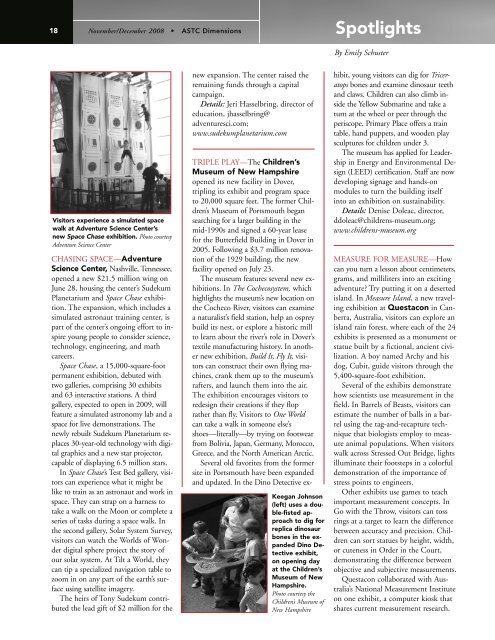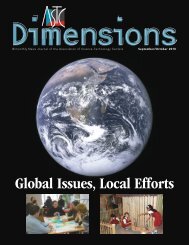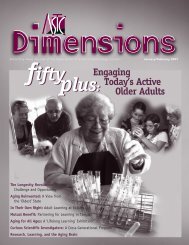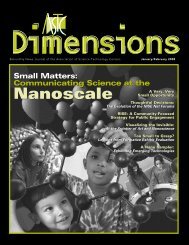Download - Association of Science - Technology Centers
Download - Association of Science - Technology Centers
Download - Association of Science - Technology Centers
Create successful ePaper yourself
Turn your PDF publications into a flip-book with our unique Google optimized e-Paper software.
18 November/December 2008 • ASTC Dimensions<br />
Visitors experience a simulated space<br />
walk at Adventure <strong>Science</strong> Center’s<br />
new Space Chase exhibition. Photo courtesy<br />
Adventure <strong>Science</strong> Center<br />
CHASING SPACE—Adventure<br />
<strong>Science</strong> Center, Nashville, Tennessee,<br />
opened a new $21.5 million wing on<br />
June 28, housing the center’s Sudekum<br />
Planetarium and Space Chase exhibition.<br />
The expansion, which includes a<br />
simulated astronaut training center, is<br />
part <strong>of</strong> the center’s ongoing effort to inspire<br />
young people to consider science,<br />
technology, engineering, and math<br />
careers.<br />
Space Chase, a 15,000-square-foot<br />
permanent exhibition, debuted with<br />
two galleries, comprising 30 exhibits<br />
and 63 interactive stations. A third<br />
gallery, expected to open in 2009, will<br />
feature a simulated astronomy lab and a<br />
space for live demonstrations. The<br />
newly rebuilt Sudekum Planetarium replaces<br />
30-year-old technology with digital<br />
graphics and a new star projector,<br />
capable <strong>of</strong> displaying 6.5 million stars.<br />
In Space Chase’s Test Bed gallery, visitors<br />
can experience what it might be<br />
like to train as an astronaut and work in<br />
space. They can strap on a harness to<br />
take a walk on the Moon or complete a<br />
series <strong>of</strong> tasks during a space walk. In<br />
the second gallery, Solar System Survey,<br />
visitors can watch the Worlds <strong>of</strong> Wonder<br />
digital sphere project the story <strong>of</strong><br />
our solar system. At Tilt a World, they<br />
can tip a specialized navigation table to<br />
zoom in on any part <strong>of</strong> the earth’s surface<br />
using satellite imagery.<br />
The heirs <strong>of</strong> Tony Sudekum contributed<br />
the lead gift <strong>of</strong> $2 million for the<br />
new expansion. The center raised the<br />
remaining funds through a capital<br />
campaign.<br />
Details: Jeri Hasselbring, director <strong>of</strong><br />
education, jhasselbring@<br />
adventuresci.com;<br />
www.sudekumplanetarium.com<br />
TRIPLE PLAY—The Children’s<br />
Museum <strong>of</strong> New Hampshire<br />
opened its new facility in Dover,<br />
tripling its exhibit and program space<br />
to 20,000 square feet. The former Children’s<br />
Museum <strong>of</strong> Portsmouth began<br />
searching for a larger building in the<br />
mid-1990s and signed a 60-year lease<br />
for the Butterfield Building in Dover in<br />
2005. Following a $3.7 million renovation<br />
<strong>of</strong> the 1929 building, the new<br />
facility opened on July 23.<br />
The museum features several new exhibitions.<br />
In The Cochecosystem, which<br />
highlights the museum’s new location on<br />
the Cocheco River, visitors can examine<br />
a naturalist’s field station, help an osprey<br />
build its nest, or explore a historic mill<br />
to learn about the river’s role in Dover’s<br />
textile manufacturing history. In another<br />
new exhibition, Build It, Fly It, visitors<br />
can construct their own flying machines,<br />
crank them up to the museum’s<br />
rafters, and launch them into the air.<br />
The exhibition encourages visitors to<br />
redesign their creations if they flop<br />
rather than fly. Visitors to One World<br />
can take a walk in someone else’s<br />
shoes—literally—by trying on footwear<br />
from Bolivia, Japan, Germany, Morocco,<br />
Greece, and the North American Arctic.<br />
Several old favorites from the former<br />
site in Portsmouth have been expanded<br />
and updated. In the Dino Detective ex-<br />
Keegan Johnson<br />
(left) uses a double-fistedapproach<br />
to dig for<br />
replica dinosaur<br />
bones in the expanded<br />
Dino Detective<br />
exhibit,<br />
on opening day<br />
at the Children’s<br />
Museum <strong>of</strong> New<br />
Hampshire.<br />
Photo courtesy the<br />
Children’s Museum <strong>of</strong><br />
New Hampshire<br />
Spotlights<br />
By Emily Schuster<br />
hibit, young visitors can dig for Triceratops<br />
bones and examine dinosaur teeth<br />
and claws. Children can also climb inside<br />
the Yellow Submarine and take a<br />
turn at the wheel or peer through the<br />
periscope. Primary Place <strong>of</strong>fers a train<br />
table, hand puppets, and wooden play<br />
sculptures for children under 3.<br />
The museum has applied for Leadership<br />
in Energy and Environmental Design<br />
(LEED) certification. Staff are now<br />
developing signage and hands-on<br />
modules to turn the building itself<br />
into an exhibition on sustainability.<br />
Details: Denise Doleac, director,<br />
ddoleac@childrens-museum.org;<br />
www.childrens-museum.org<br />
MEASURE FOR MEASURE—How<br />
can you turn a lesson about centimeters,<br />
grams, and milliliters into an exciting<br />
adventure? Try putting it on a deserted<br />
island. In Measure Island, a new traveling<br />
exhibition at Questacon in Canberra,<br />
Australia, visitors can explore an<br />
island rain forest, where each <strong>of</strong> the 24<br />
exhibits is presented as a monument or<br />
statue built by a fictional, ancient civilization.<br />
A boy named Archy and his<br />
dog, Cubit, guide visitors through the<br />
5,400-square-foot exhibition.<br />
Several <strong>of</strong> the exhibits demonstrate<br />
how scientists use measurement in the<br />
field. In Barrels <strong>of</strong> Beasts, visitors can<br />
estimate the number <strong>of</strong> balls in a barrel<br />
using the tag-and-recapture technique<br />
that biologists employ to measure<br />
animal populations. When visitors<br />
walk across Stressed Out Bridge, lights<br />
illuminate their footsteps in a colorful<br />
demonstration <strong>of</strong> the importance <strong>of</strong><br />
stress points to engineers.<br />
Other exhibits use games to teach<br />
important measurement concepts. In<br />
Go with the Throw, visitors can toss<br />
rings at a target to learn the difference<br />
between accuracy and precision. Children<br />
can sort statues by height, width,<br />
or cuteness in Order in the Court,<br />
demonstrating the difference between<br />
objective and subjective measurements.<br />
Questacon collaborated with Australia’s<br />
National Measurement Institute<br />
on one exhibit, a computer kiosk that<br />
shares current measurement research.





